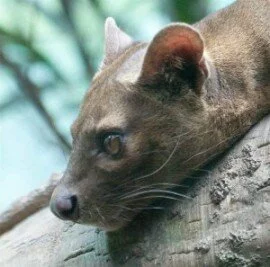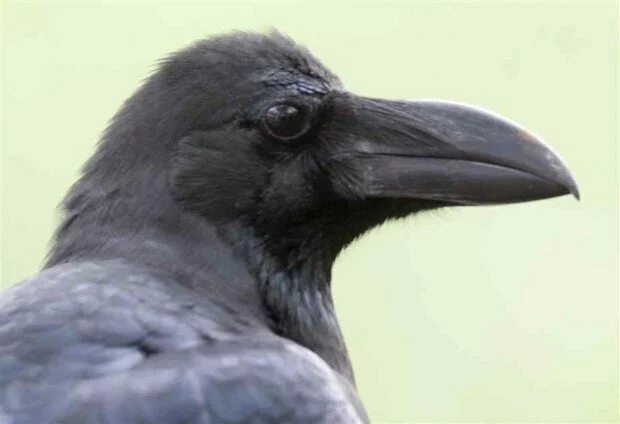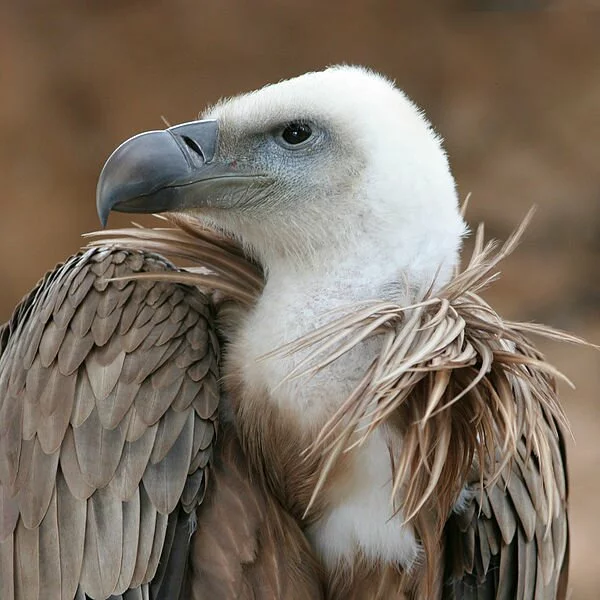The Fauna of Madagascar: Fossas
The island of Madagascar is well known for its ecosystem of unique and unusual species, making it a destination for many scientists who seek to study the adaptations which creatures undergo when isolated from the rest of the world for many generations. The island is often associated with the lemurs which inhabit its forests, but these are not the only atypical creatures inhabiting Madagascar. In fact, the lemurs’ main predator ranks among the most unconventional of the ecosystem’s species. This animal is none other than the cunning and agile fossa. This top predator essentially rules over the island, preying on nearly anything it can seize. It is also a fairly elusive creature which has not been studied extensively and has served to puzzle the few scientists who have had the chance to observe it since the 1830’s due to its combination of feline and canine features. This makes the fossa a shining example of Madagascar’s extraordinarily beautiful wildlife.
Despite appearing to be a cross between a canine and a feline, the fossa (Cryptoprocta ferox) is actually a relative of the mongoose. This species can grow to lengths of 6 feet and weigh up to 26 lbs.[1] It possesses a short muzzle like that of a dog’s, prominent ears, and large, forward-facing eyes.[2] The dentition hints strongly towards the animal’s carnivorous diet, as it possesses a fearsome set of catlike teeth.[3] This creature’s vibrissae, or whiskers, are easily noticeable and can grow almost as long as the animal’s head. The tail is nearly as long as its slender body and it possesses semi-retractable claws which enable the species to climb trees effectively in search of prey. A notable feature of the fossa is its plantigrade method of locomotion, where the animal walks on the soles of its feet (much like bears). The body is covered in short, thick fur which is often of a reddish-brown coloration, though fossas with black fur have been observed as well.[4]
Due to the features it shares with several different types of animals, there has been considerable dispute over the proper taxonomy of the fossa. Originally, it was classified as a felid due to its catlike head and body. However, scientists now agree that this general resemblance to the members of the family Felidae is simply due to convergent evolution, where two (or more) separate lineages acquire similar biological traits as they adapt to their own habitats. The fossa was later placed in the family Viverridae as a result of its apparent resemblance to civets and genets. Subsequent studies, however, have suggested that it belongs to a small group of Malagasy carnivores known as the Eupleridae, which also contains the falanouc (Eupleres goudotii) and the Malagasy civet (Fossa fossanna). The Eupleridae have the unfortunate distinction of being the only carnivore family where all representatives are listed threatened by the IUCN (International Union for Conservation of Nature); four species are listed as vulnerable and four are considered endangered. Recent molecular studies of these eight Malagasy carnivore species indicates that they all originated from a common ancestor that is thought to have colonized Madagascar from mainland Africa 18-24 million years ago. The fossa and the Malagasy civet are believed to be the most ancient surviving members of this group. While the fossa is the only extant species of the genus Cryptoprocta, fossil evidence dictates that a larger fossa species weighing up to 37 lbs existed on Madagascar in the recent geological past.[5]
The fossa occurs throughout the less disturbed forests of Madagascar and it is absent in areas where forests have been cleared, though the species can be observed passing through nonforest habitats as transient individuals. It is found from sea level up to around 2600 meters above sea level on the Andringitra Massif. The fossa exhibits both arboreal and terrestrial behavior, as it is an excellent climber (it moves so swiftly through the trees that scientists often struggle to observe and study it) but is equally at home on the forest floor. This adaptability allows the animal greater success in locating its food, raising its chances of survival.
The fossa is a solitary species and is thus found in low population densities throughout its range. The population densities for the Menabe region (located in western Madagascar) are 0.26 individuals/km² and 0.20 individuals/km² for Ankarafantsika (a national park in northwestern Madagascar). A recent estimate incorporating 25 protected areas large enough to support a population (though not necessarily a viable one) lists the current population size at less than 2,500 individuals. Furthermore, the maximum estimated population for Masoala national Park (the largest protected area in Madagascar) is 414 breeding adults, and this may very well be a substantial overestimate as the species tends to range between forest patches. There is currently no conclusion concerning the connectivity of fossa populations between distant forest fragments. Based on phototrapping and cage trapping efforts, the densities for Madagascar’s eastern forests are hypothesized by some to be at one-third that of the west. The subjective encounter rate is much higher in western forests than in rainforests, though densities could well be similar between dry and humid forests. Likely factors for these different population densities are the amount of available prey as well as levels of hunting.[6]
As the apex predator of Madagascar, the fossa enjoys an extensive list of possible prey items. Among these are small mammals, birds, reptiles, amphibians, and insects.[7] It is lemurs, however, which are the fossa’s preferred prey. In fact, the fossa is the only species studied to date whose primary prey is a primate. In studies from Madagascar’s western dry forests, more than 50% of the diet of fossas (ascertained from scats) was found to be large diurnal lemurs. The catlike predators appear to preferentially hunt at night, using the darkness to conceal them from their unsuspecting prey. Should a targeted lemur take notice of the predator and attempt to flee, the fossa can easily give chase. Using their claws and hairless footpads to achieve greater gripping power while employing their long tails as balancing organs, the fossa is able to keep up with its agile prey. Jumping from one branch to another is of no hindrance to this formidable predator, either, as its long hindlimbs allow it to leap impressively from one branch to another as it chases down its target. Killing its prey is also not a problem since its muscular body allows it to take down even the largest lemur species.[8]
The fossa reaches sexual maturity at slightly over four years of age. Mating season lasts from September to October. During this time, a sexually mature female will exclusively occupy a sight high in a tree and signify her readiness to mate by lifting her hindquarters and turning her external genital inside out about two to three centimeters. Once two or more males encounter the same female, competition ensues. Aggression between the males is carried out in the form of threatening calls and postures which can lead to fights where the rivals attempt to bite each other. Over the course of a week, the female will mate with several different males and then leave the area. Upon her departure, a new female will take her place in the tree and mate with the males there (it should be noted that these “mating trees” are used for many years by fossas).[9] Copulation can occur either on the ground or on a horizontal branch. The male mounts the female and bites her neck in a mating process that can last for more than two hours. After a three month gestation period, the female gives birth to two to four young in a den. The young fossas weigh about 3.5 oz during this time and are toothless and blind (though they are born with fur). After four and a half months, the young are weaned and venture out of the den for the first time. At the age of 15-20 months, the young become independent and leave their mother. They develop adult teeth at the age of two years and reach adult size after four years.[10]
It may seem as if the fossa has nothing to worry about. It is a formidable predator which possesses no natural predators of its own and enjoys a wide variety of prey to choose from. However, that is far from the case. As its rather low population numbers depict, the species has been on the receiving end of a variety of the negative stresses created by nearby humans for some time. The loss and fragmentation of forest habitat caused by the conversion of forested areas to agricultural land, pasture, and selective logging have many of these creatures without a suitable habitat to support them. The fossa’s tendency to prey on domestic fowl has also created a negative relationship between it and local people, who have consequently killed it as a pest. Furthermore, groups of people engaged in collective group hunting have added to the reduction of the species’ population numbers. The species is not only killed due to its reputation as a pest, but also due to the fact that some fossa parts are used for medicinal purposes. The introduction of feral carnivores such as dogs to Madagascar has also provided the fossa with an unexpected new competitor, and it is not unusual for dog packs to attack and kill fossas.
Fortunately, the fossa inhabits many protected areas throughout Madagascar. It is also the subject of a successful ex situ captive breeding program.[11] This species’ unique nature had already captured the interests of many scientists for decades, and its dwindling numbers have thus alarmed many people. Researchers from the Wildlife Conservation Society (WCS) are currently studying the fossa in the Makira National Park. These researchers are focusing their studies on the ecology of this species as well as the possible threats from bushmeat hunters. Researchers from Duke University have also been studying fossa behavior and ecology since 1996 with support from the conservation charity Earthwatch. They are focusing on the competitive threat posed by the Indian civet (Viverricula indica) and introduced wild cats. They are also raising awareness among the Malagasy people of the fossa’s ecological role in the wild as a predator of several animals which are considered crop pests and training local people to study and conserve the species. Awareness of the species’ needs has led to the government plan known as the “Durban Vision,” which seeks to increase Madagascar’s protected habitats from 1.7 to 6 million hectares, a massive improvement which should protect much of the country’s famous biodiversity, including the fossa. The locations of traditional “mating trees” must be taken into account when carrying out a plan such as this. If the trees are not included in protected areas then the fossas are likely to leave the reserves in order to use the trees during mating season, making them vulnerable once more to their common threats.[12]
The fossa is a rather odd creature, but perhaps that should not come across as a surprise considering its role as the ruling predator of an ecosystem teeming with strange and rare creatures. Separated from the rest of the world millions of years ago, the fossa and the species it shares its habitat with have developed into an unusual collection of animals which have nonetheless captured the interests of many scientists over the course of the generations since their discovery. Unfortunately, like countless other fascinating species, the fossa’s future (along with the futures of many other Malagasy species) has been shaken by humans. It has been hunted greatly and the forests it inhabits have been largely destroyed. Yet Madagascar’s biodiversity may still have a future, as this is one ecosystem which is considered especially significant by many people due to its collection of unique creatures found nowhere else in the world. If Madagascar’s biodiversity is truly provided with the care and protection it requires, then the fossa and its fellow Malagasy species can live on to continue down the aberrant path their isolated ancestors undertook long, long ago.
[1] “Fossa.” www.animals.nationalgeographic.com. http://animals.nationalgeographic.com/animals/mammals/fossa/ (accessed January 14, 2012).
[2] “Fossa.” www.edgeofexistence.org. http://www.edgeofexistence.org/mammals/species_info.php?id=43 (accessed January 14, 2012).
[3] “Fossa.” www.animals.nationalgeographic.com. http://animals.nationalgeographic.com/animals/mammals/fossa/ (accessed January 14, 2012).
[4] Lundrigan, Barbara, & Zachariah, Trevor. “Cryptoprocta ferox.” www.animaldiversity.ummz.umich.edu. http://animaldiversity.ummz.umich.edu/site/accounts/information/Cryptoprocta_ferox.html (accessed January 14, 2012).
[5] “Fossa.” www.edgeofexistence.org. http://www.edgeofexistence.org/mammals/species_info.php?id=43 (accessed January 14, 2012).
[6] “Cryptoprocta ferox.” www.iucnredlist.org. http://www.iucnredlist.org/apps/redlist/details/5760/0 (accessed January 14, 2012).
[7] Lundrigan, Barbara, & Zachariah, Trevor. “Cryptoprocta ferox.” www.animaldiversity.ummz.umich.edu. http://animaldiversity.ummz.umich.edu/site/accounts/information/Cryptoprocta_ferox.html (accessed January 14, 2012).
[8] “Fossa.” www.waza.org. http://www.waza.org/en/zoo/visit-the-zoo/small-carnivores-1254385523/cryptoprocta-ferox (accessed January 14, 2012).
[9] “Fossa.” www.edgeofexistence.org. http://www.edgeofexistence.org/mammals/species_info.php?id=43 (accessed January 14, 2012).
[10] Lundrigan, Barbara, & Zachariah, Trevor. “Cryptoprocta ferox.” www.animaldiversity.ummz.umich.edu. http://animaldiversity.ummz.umich.edu/site/accounts/information/Cryptoprocta_ferox.html (accessed January 14, 2012).
[11] “Cryptoprocta ferox.” www.iucnredlist.org. http://www.iucnredlist.org/apps/redlist/details/5760/0 (accessed January 14, 2012).
[12] “Fossa.” www.edgeofexistence.org. http://www.edgeofexistence.org/mammals/species_info.php?id=43 (accessed January 14, 2012).


